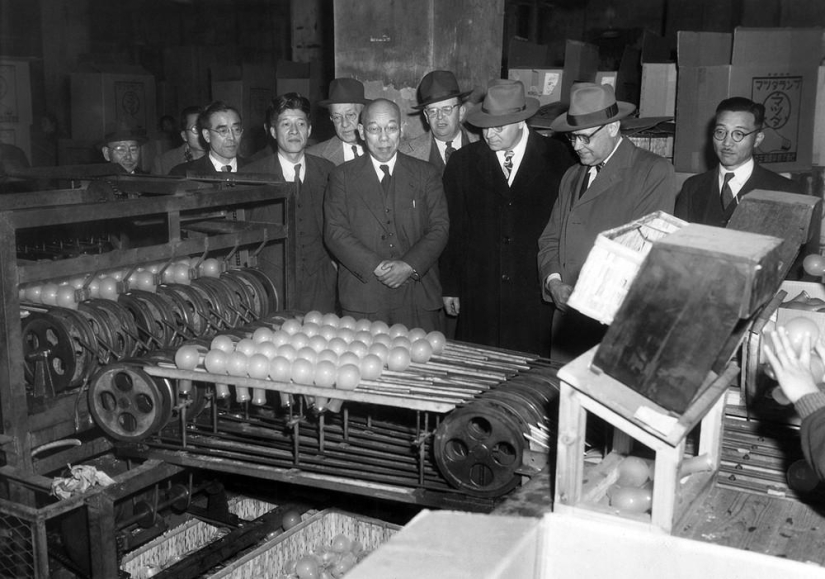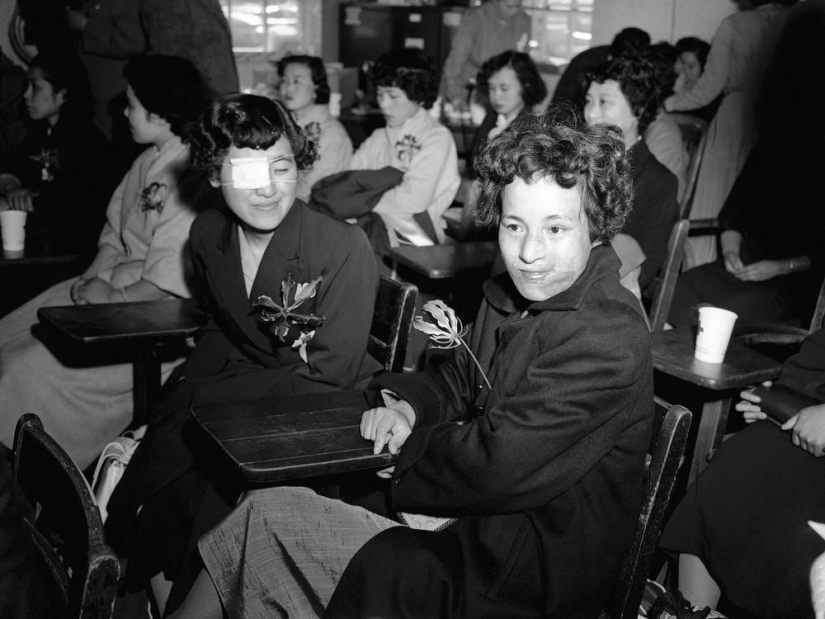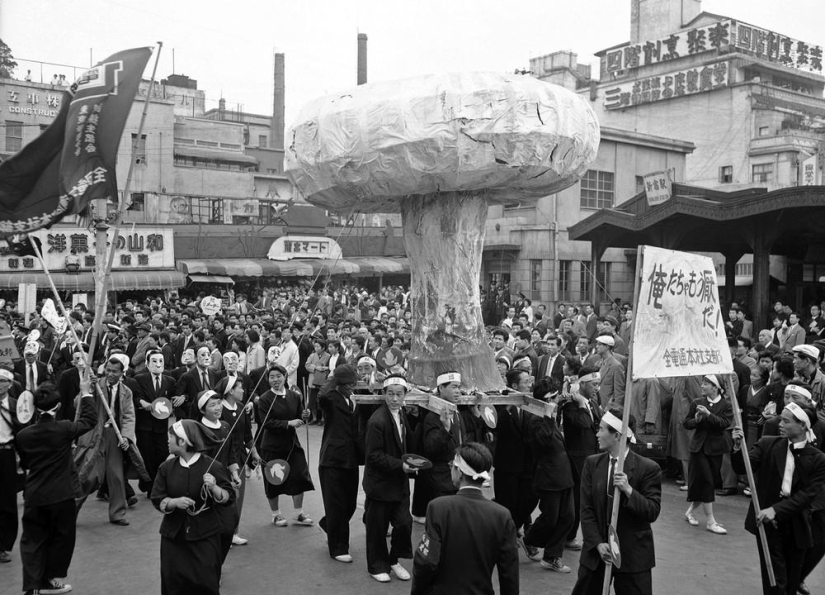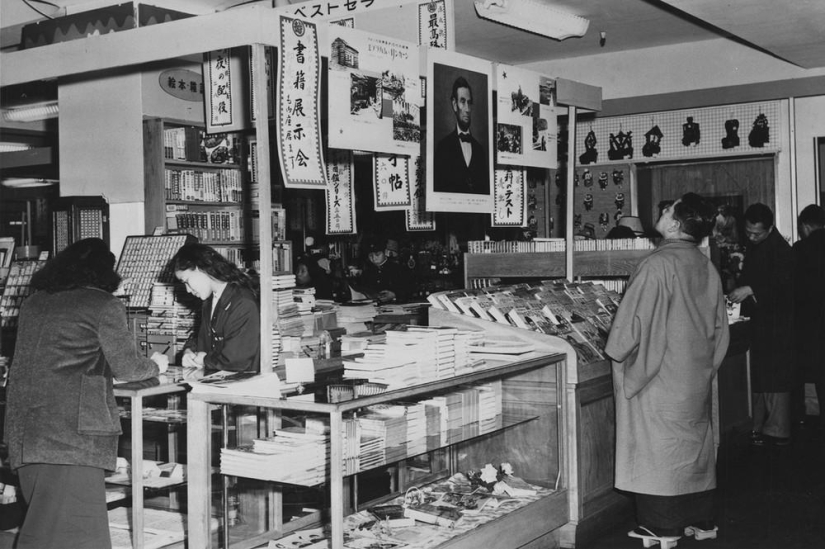What was Japan in the 50s? How people dressed on the streets? How things have changed since then, the Japanese city? And what new items and events have shocked the people of this amazing country at the time? Well, we have the opportunity to go back in time and look at Japan in the 50s.


College students are hired to "stamp" the passengers into cars in Tokyo. (Photo by Library of Congress via The Atlantic)

Meet women returned home from captivity Japanese soldiers on 26 April 1950. Men carry the remains of their fallen comrades. (Photo by AP Photo via The Atlantic)

Bombers b‑26 is ready to take off in the far East of the airfield in Japan, 20 September 1950 on a combat mission in Korea. Twin-engine bombers all day provided support to ground forces of the UN. (Photo by AP Photo/U.S. Air Force via The Atlantic)

The girl carefully sorts pearls raised on the farm Kokichi Mikimoto, on the Peninsula of ISE, 12 October 1949. At this stage, pearls sorted according to color, size and shape. (Photo by AP Photo via The Atlantic)

To attract public attention to new swimwear line, 5 June 1950 shop in Tokyo used live models instead of mannequins. Even the rain didn't stop the curious passers-by, and, it seems, and the girls and the audience liked the idea to see each other through the glass. (Photo by AP Photo via The Atlantic)

Dining room in an orphanage in Osaka on 19 February 1951. Every day here fed 160 orphans. Food bought with funds 27th infantry regiment of the US army. (Photo by Jim Pringle/AP Photo via The Atlantic)

Experts on the job training watch as the device resets the bulb down to another part of the plant where they are sorted manually in Tokyo on 25 January 1951. (Photo by Arthur Curlis/AP Photo/U.S. Army via The Atlantic)

3 August 1951, six years after the explosion of the atomic bomb in Hiroshima, the girls stand next to a souvenir shop on the street near the destroyed dome Industrial hall. The owner of the shop of Kioshi between Yoshikawa, suffered during the explosion. (Photo by AP Photo/Kyodo via The Atlantic)

The passengers of the train Tokyo to Osaka during the three-minute gymnastics instructor-led in Hamamatsu 27 August 1952, where the train stopped for 5 minutes. This unusual service was organized in order to help passengers to stretch their legs during a long journey between the two cities. At the station even had a platform for instructors and music. (Photo by Max Desfor/AP Photo via The Atlantic)

Examination of the lens at the Tokyo factory for the production of cameras on 5 January 1952. (Photo by Bob Schutz/AP Photo via The Atlantic)

Protesters clash-the Communists and the Japanese police in Tokyo on may 1, 1952. There were many victims on both sides: the police used tear gas and batons. (Photo by Max Desfor/AP Photo via The Atlantic)

Bloodied young man is removed from the scene of the protests after clashes between police and demonstrators on may 1, 1952 in Tokyo. (Photo by AP Photo via The Atlantic)

Children of a Japanese family returning home, play on the deck of the Koan Maar while traveling in the Gulf of Maizuru 24 March 1953. The first group of families returned from Communist China, where they were with the end of the Second world war. Only to 1953, the year they finally go home. The first group of 2,000 people arrived from Northern China to the koan of the Maar. Bicycle children gave to charities. (Photo by Ishizaki Y. Jackson/AP Photo via The Atlantic)

Employee Studio working on a model ship before filming a documentary about the battleship Yamato on 8 June 1953. (Photo by Yuichi Ishizaki/AP Photo via The Atlantic)

Filming of "Yamato" in the Studio pool, a Japanese film company Shin-Toho June 8, 1953. (Photo by Yuichi Ishizaki/AP Photo via The Atlantic)

The last day of the filming of the documentary "Yamato". (Photo by Yuichi Ishizaki/AP Photo via The Atlantic)

On the island of IO Japanese workers dismantle the ship for scrap on 21 February 1954. After 9 years the Japanese have returned to the island of IO, but as groups on shipbreaking. (Photo by AP Photo via The Atlantic)

Viewers with fans watching a baseball game between the universities of Keio and Waseda in Tokyo on 1 June 1954. Left the Japanese leader of the support group cheering spectators, whose fans painted in the colors of a University. (Photo by AP Photo via The Atlantic)

Ten thousand lights illuminate a new tower television stations in Central Tokyo on March 26, 1955, during the biggest picture with the flash in the world. Radio Tokyo, together with local company to manufacture light bulbs, adorned new 157-meter TV antenna 10,000 light bulbs in the promo for the discovery channel on April 1. Thousands of photographers gathered on the upper floors and the roofs of neighboring buildings to commemorate the event. (Photo by AP Photo via The Atlantic)

45 operators and journalists take pictures of the new office of the Japanese Prime Minister in Tokyo on 17 December 1954. Usually Japanese Newspapers were sent to reports of 3-4 photographer to capture the event from all possible angles. (Photo by AP Photo via The Atlantic)

Nurses of the newly formed self-defense forces in Hokkaido, during maneuvers on 20 October 1955. Japanese forces came to military exercises against an imaginary opponent. (Photo by AP Photo via The Atlantic)

Tokyo from a height of 5 August 1955. Modern buildings gradually fill up areas of the city. The Sumida river flows quietly through the quarter Chamaco (foreground) and the district Fukanaga. Most of these areas are occupied by warehouses. (Photo by AP Photo via The Atlantic)

Japanese women Mitsuko of Kuramoto (left) and Emiko Takemoto, survivors of a nuclear attack in Hiroshima 10 years ago, sitting at a military base in long island, new York, may 9, 1955. 25 Japanese women injured in the blast, arrived to new York in hopes to get plastic surgery. (Photo by Jacob Harris/AP Photo via The Atlantic)

Huge atomic copy of "fungus" carry through the streets of Tokyo on may 1, 1957 in protest against the atomic bomb tests on Christmas Island. (Photo by AP Photo via The Atlantic)

Volunteers of the Japanese army during maneuvers at the military school Fuji may 15, 1957, in Tokyo. Armed with American weapons and support the tank of the US soldiers took part in an intensive military exercises on land, at sea and in the air. (Photo by George Sweers/AP Photo via The Atlantic)

Japanese children consider one of the models at the exhibition of the "open space" in a Department store in Tokyo on 19 August 1958. Here they saw a rocket that landed on the moon, strange inhabitants of the moon, and even satellite. (Photo by AP Photo via The Atlantic)

Japanese dancer troupe Shochiku rehearsing one of their rooms at the summer school of the theatre in Tokyo Kokusai 11 July 1958. (Photo by Mitsunori Chigita/AP Photo via The Atlantic)

The Tokyo Department store in 1959, where in a traditional Japanese wooden sandals examines Abraham Lincoln's portrait. (Photo by Library of Congress via The Atlantic)

Round Ohira, Japanese "voice" of Superman, looking at actor George Reeves on the screen during dubbing of the series 7 July 1959. The TV made a huge impression on the Japanese. In the ' 50s, about 99% of Japanese television was set for the American show, and "Superman" is one of the most beloved. (Photo by AP Photo via The Atlantic)

Mickey Curtis singer in the style of Elvis Presley – in concert at the theatre Nichigeki in Tokyo on 18 February 1958. The fans can't resist the desire to touch him. Japan has captured the madness rock-n-roll. Screaming, moaning, cheering teenagers scored the theatre to capacity. (Photo by AP Photo via The Atlantic)

Japanese girl in a kimono could not resist "the hula Hoop-madness" that swept America and Japan. Photo taken 30 October 1958. (Photo by Mitsunori Chigita/AP Photo via The Atlantic)

Tomiko Kawabata in his car admiring his brand new portable transistor TV, which began producing company Sony. The picture was taken in Tokyo January 5, 1960. TV 8‑inch (20 cm), it is powered by batteries, which is enough for three hours and also from the usual outlets. (Photo by AP Photo via The Atlantic)
Keywords: Asia | Japan | History | 50s
Post News ArticleRecent articles

There is a perception that people only use 10% of their brain potential. But the heroes of our review, apparently, found a way to ...

We never know where and when we will come across something unknown, beautiful, and at first glance, unreal. In this post you will ...
Related articles

In the fall of 1972, Bill Yates traveled through the countryside in the vicinity of Tampa, Florida. At that time, he was studying ...

When a person is in a life-threatening situation is awful, but even worse when it happens to a child. 11-year-old American Terry ...

Remember how broke the "unbreakable" scoop? The photo preserved in the photo album of almost every family! A selection of vintage ...

It's high time to admit that this whole hipster idea has gone too far. The concept has become so popular that even restaurants have ...